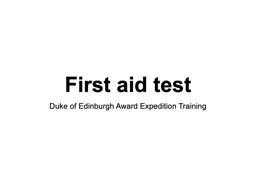

Q1 How might you know whether someone is in shock Identify all the possible signs and symptoms Sweating Pale cold or clammy skin Severe bleeding Fast shallow breathing Q2 What does DR ABC stand for ID: 910930
Download Presentation The PPT/PDF document "First aid test Duke of Edinburgh Award E..." is the property of its rightful owner. Permission is granted to download and print the materials on this web site for personal, non-commercial use only, and to display it on your personal computer provided you do not modify the materials and that you retain all copyright notices contained in the materials. By downloading content from our website, you accept the terms of this agreement.
Slide1
First aid test
Duke of Edinburgh Award Expedition Training
Slide2Q1. How might you know whether someone is in shock?
(Identify all the possible signs and symptoms.)
Sweating
Pale, cold or clammy skin
Severe bleeding
Fast, shallow breathing
Slide3Q2.
What does DR ABC stand for?
(Identify the ONE correct answer.)
Danger, Ring, Airway, Breathing, Circulation
Danger, Response, Alert, Breathing, Circulation
Danger, Response, Airway, Breathing, Circulation
Danger, Response, Airway, Breaks, Circulation
Slide4Q3. How would you treat a cut or graze?
(Identify all possible treatment.)
Clean and dry the skin
Splinter the wound
Apply direct pressure
Raise up the wound
Slide5Q4. If you have been bitten by a tick, what might suggest you have caught Lyme’s disease?
(Identify all the possible signs and symptoms.)
Circular red rash on your skin
Muscle and joint pains
Numbness or tingly feeling
Headaches
Slide6Q5. How might you know if someone is having an allergic reaction?
(Identify all the possible signs and symptoms.)
Complaining of a migraine
Skin appears blotchy or is itchy
Itchy red eyes or nose
Swelling of hands or feet
Slide7Q6. How do you treat a casualty who is having an asthma attack?
(Identify all possible treatment.)
Reassure the casualty
Help them take their inhaler
Put their head between their legs
Help them breathe slowly and deeply
Slide8Q7. How can you prevent blisters on your feet?
(Identify all possible preventable actions.)
Wear two pairs of socks (a liner pair)
Turn your socks inside out
Keep socks (and feet) dry
Apply tape or plastics to 'hotspots'
Slide9Q8. When would you apply indirect pressure to a wound that is severely bleeding?
(Identify the ONE correct answer.)
When there is an embedded object
After removing an embedded object
Indirect pressure should never be applied
When a wound is above a casualty's heart
Slide10Q9. How is heatstroke different from heat exhaustion?
(Identify all the correct differences.)
Heatstroke happens quickly
A casualty can become unresponsive
There is little warning
A casualty's the brain is no longer regulating the body's temperate
Slide11Q10. When treating a strain or sprain, what does RICE stand for?
(Identify the ONE correct answer.)
Rest, Ice, Compression and Ease
Rest, Ice, Compression and Elevation
Rest, Indirect pressure, Compression and Elevation
Response, Ice, Compression and Elevation
Slide12First Aid Answers
Q 1. a, b, d
Q 2. 3
Q 3. a, c, d
Q 4. a, b, c, d
Q 5. b, c, d
Q 6. a, b, d
Q 7. a, c, d
Q 8. 1
Q 9. a, b, c, d
Q10. 2